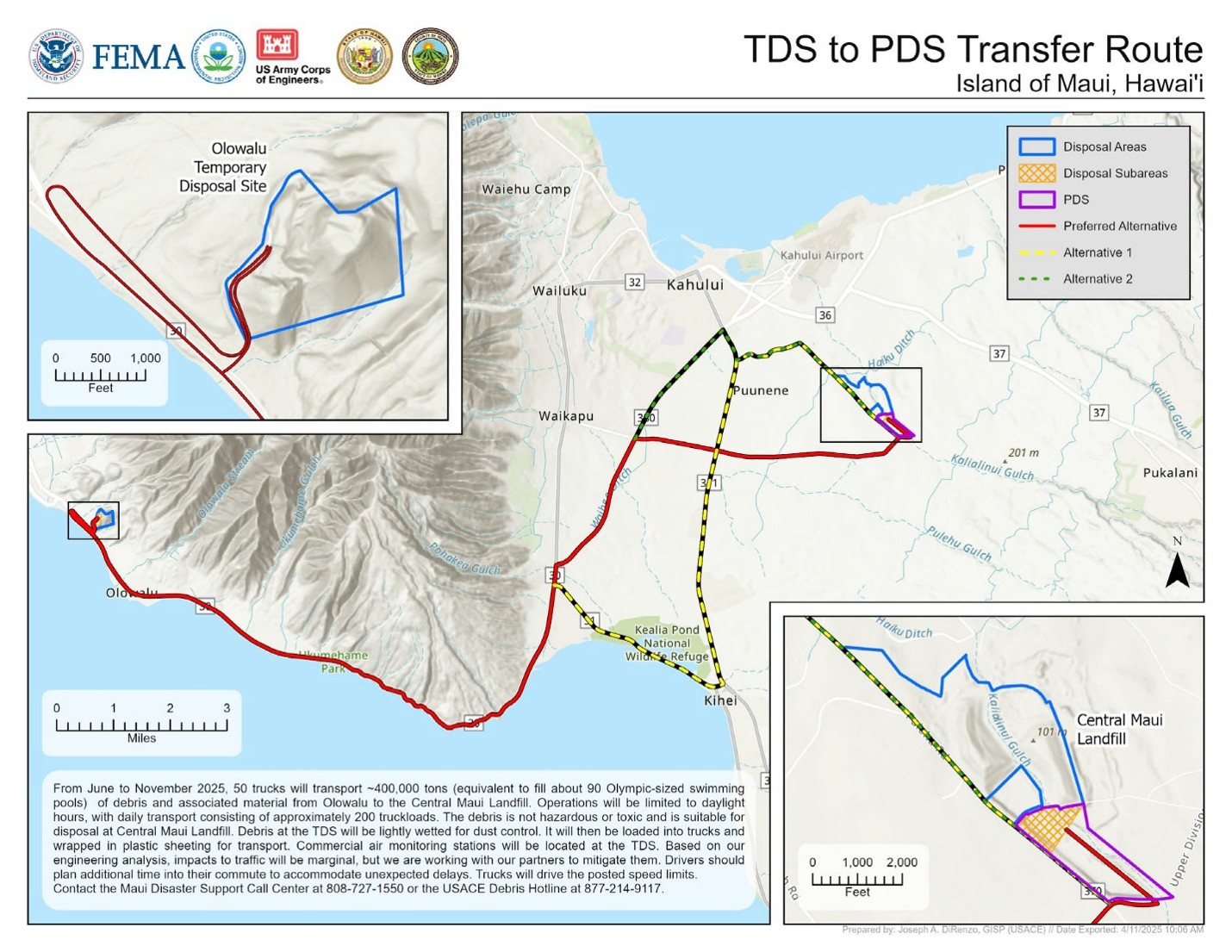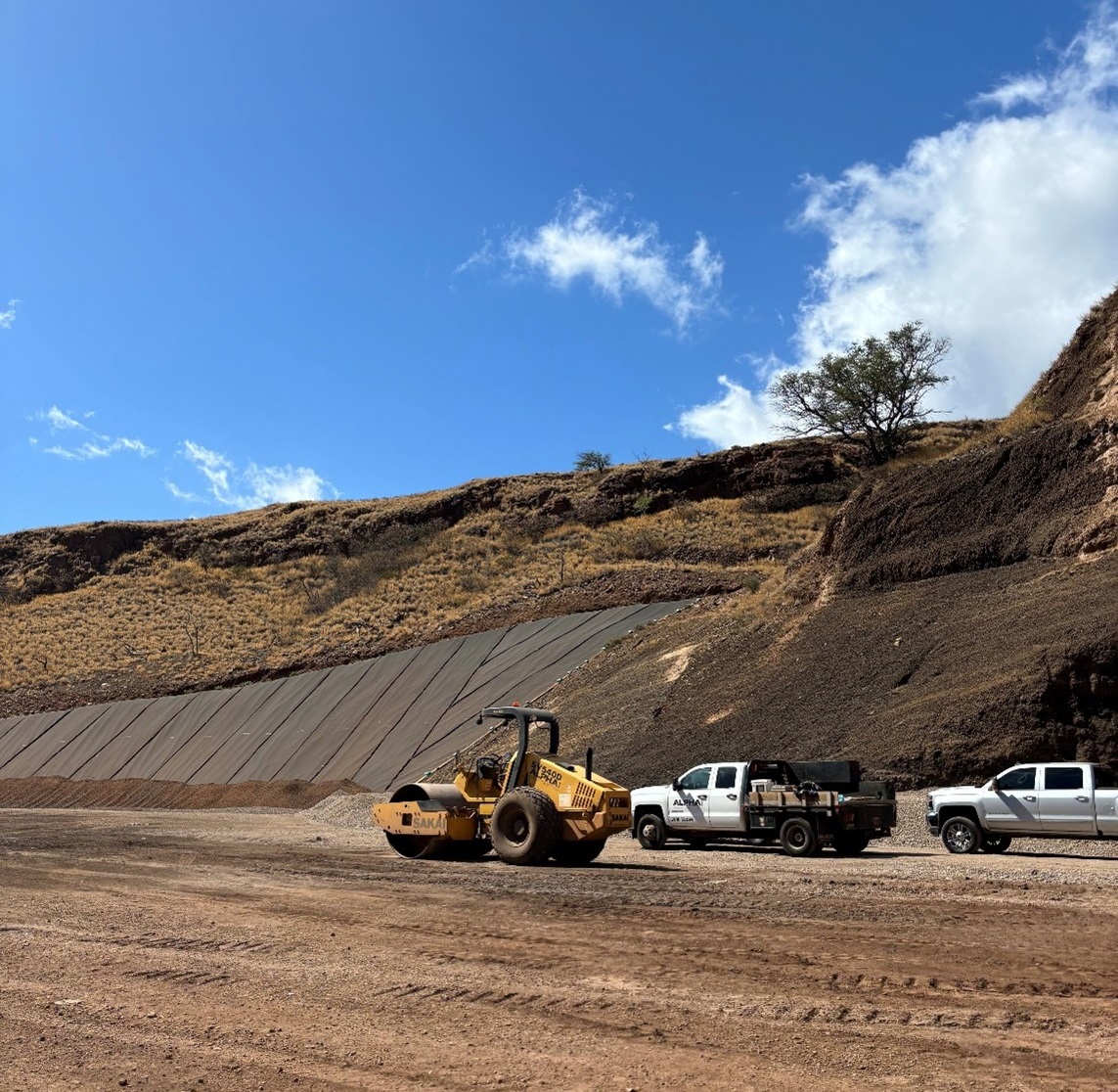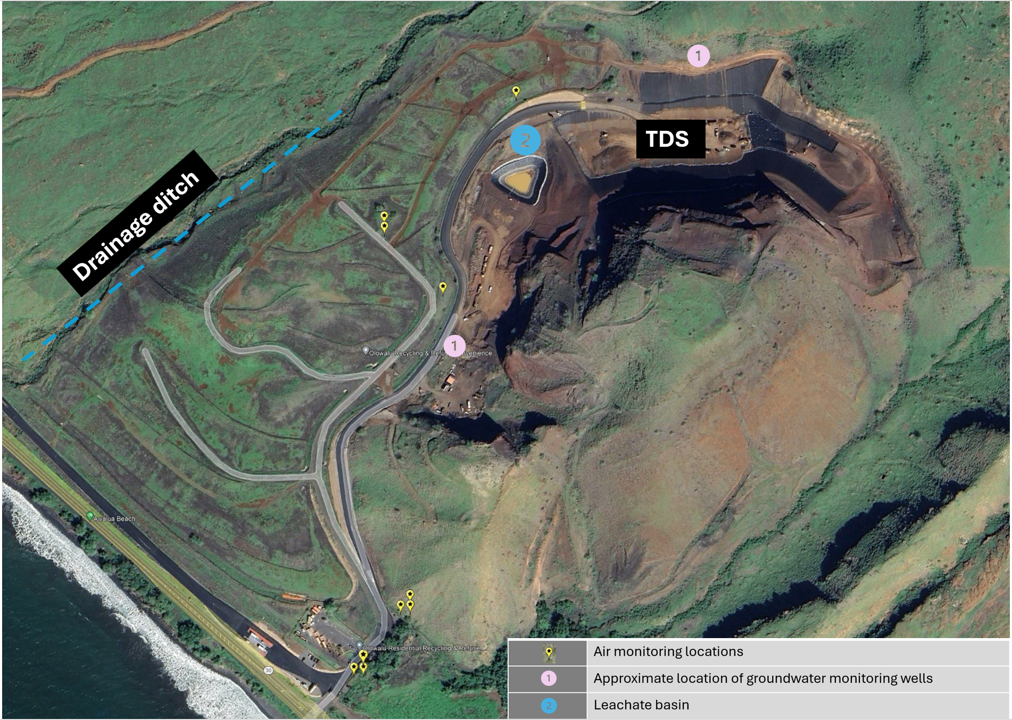West Maui TDS Site
Air | Ash and Debris | Beach Sand | Coastal Sediment | Coastal Waters | County Parks | West Maui TDS Site | Soil
Maui Wildfire Data: West Maui Temporary Debris Storage (TDS) Site
TDS Site page text and figures are current through August 29, 2025. Access the most recent data.
Debris removal in Lahaina was a critical step in the larger wildfire recovery efforts. Debris removal involved clearing and disposing of materials and waste burned in the fire, some of which may have been hazardous to human health. It involved a controlled process to ensure the safe collection, removal, transportation, and storage of debris so that people could safely re-enter their communities and rebuild.
Sampling data collected to date show that the West Maui Temporary Debris Storage Site is not releasing harmful substances into the environment at levels of health concern.
The West Maui Temporary Debris Storage (TDS) Site, located in Olowalu, received over 380,000 tons of ash and debris from Lahaina from January 2024 to January 2025. This site was designed to protect soil, groundwater, and coastal waters from any environmental impact from ash and debris. As of January 2025, the TDS Site no longer accepted debris and ash from commercial or residential properties in Lahaina.
Transfer to the Permanent Disposal Site (PDS)
The West Maui TDS Site served as a temporary site for ash and debris disposal until the PDS could be constructed. On February 28, 2024, Mayor Richard Bissen announced that the PDS would be at the Central Maui Landfill. The PDS needed to be constructed and operational prior to ash and debris transfer from the TDS Site to the PDS. The County of Maui and USACE developed a plan with processes and procedures for the safe loading, transportation, and disposal of ash and debris at the PDS, as well as closure of the TDS Site. The transfer process began in mid-June 2025 and is expected to continue until November 2025. Procedures include the following:
- After Lahaina cleanup efforts were completed, the TDS Site was temporarily closed and secured.
- Ash and debris are loaded out and secured with polyethylene plastic liners with additional tarps during transport by truck to the PDS.
- Trucks leaving the loadout area pass across mats designed to remove debris and prevent tracking out of material along the access road.
- Earthen cover is replaced daily to control dust at the TDS Site and the PDS.
- Water trucks are used to control dust during excavation, loading, and loadout.
- The County of Maui works with DOH and USACE to monitor both the PDS and the TDS Site as transfer to the PDS takes place, including dust monitoring and perimeter air monitoring. Current air monitoring reports are available for download.
- Leachate monitoring, stormwater diversion, and groundwater monitoring will continue to take place until transfer is complete, and the TDS Site is restored.
- After all debris transfer from the TDS Site to the PDS is complete, the protective liner at the TDS Site will be removed and soil sampling will be conducted to ensure no impact on the land or public health.
- After transfer is complete, the groundwater monitoring wells will be properly decommissioned and sealed.
- TDS Site areas will be graded as close to original conditions as possible.
- Plans and progress, including transfer route, will be communicated to the public.
The transfer of debris from the TDS Site to the PDS and the TDS Site closure are expected to take about one year. For more information on this process, the public can contact the USACE hotline (877-214-9117) or the County of Maui (808-270-7297). Maui Recovers provides additional information about the TDS–PDS Transfer and Closure Plan (opens in a new tab).

TDS Site Monitoring
As transfer to the PDS takes place, the U.S. Army Corps of Engineers (USACE) will continue to monitor and carefully manage debris at the TDS Site. USACE, DOH, and partners collect environmental samples to ensure that the debris is properly managed. The County of Maui’s Bill 120 (PDF, opens in a new tab) requires TDS Site operators to conduct monitoring and publish the sampling results in a report to the public every 90 days. The monitoring checks whether harmful substances at the TDS Site are entering the air, the groundwater beneath the site, or the water that runs through the TDS Site.
USACE has taken the following steps to protect human health and ensure that debris and ash removed from Lahaina do not pollute the air and water resources (stormwater, surface waters, and groundwater) around the TDS Site and the PDS:
- Prohibiting large truck dumping when wind speeds are high.
- Using water sprays on high-dust days to keep ash out of the air.
- Covering collected material with clean soil or volcanic rock to reduce windblown dust.
- Setting truck speed limits on dirt roads.
- Diverting stormwater around the TDS Site and the PDS to prevent it from contacting ash and debris. The storm drains throughout the site have inlet protection to prevent harmful substances in stormwater from entering the basin.
- Collecting leachate (liquid, mostly stormwater, that has contacted the active ash/debris storage area) rather than releasing it into the environment. Stormwater that falls on the active TDS area either evaporates, is absorbed by the ash and debris, or flows as leachate to a collection basin (the leachate basin). A thick liner beneath the leachate basin prevents the leachate from leaking into underlying soils. The basin size and location do not allow the leachate to mix with stormwater, so the leachate does not reach surface water. The leachate basin is designed to hold over 1 million gallons, which is much more than the amount of leachate expected to be generated. Leachate collected in the basin does not flow outside the TDS Site.
- Constructing the TDS Site in a location that is downgradient (below) public drinking water sources to mitigate any potential for contamination of drinking water sources from the TDS Site.

Below is a summary of the TDS Site environmental monitoring data provided by USACE.
TDS Site Air Monitoring

USACE contractors used air monitors to measure airborne particles (both PM2.5 and PM10) near debris removal sites and continue to use them around the TDS Site (Figure 3). The number and locations of air monitors at the TDS Site may vary based on weather conditions and operations. USACE’s data for 2024 and 2025 are shown in Figures 4 and 5. The figures show particulate matter concentrations averaged between the two monitoring sites around the TDS Site. Particulate matter concentrations at individual monitoring sites vary, with some higher and some lower than the averages shown. Air monitoring was paused from April 30, 2025, to June 17, 2025, when the TDS Site was temporarily closed and no site operations were taking place. Monitoring resumed when transfer to the PDS began, and daily samples are being taken through the completion of transfer and closure operations. Figures 4 and 5 show that all measurements for both PM2.5 and PM10 have been below their respective action levels set for operating the TDS Site (35 μg/m3 for PM2.5 and 150 μg/m3 for PM10). : USACE’s site monitoring reports are available for download.
USACE is also providing air monitoring of the TDS to PDS transfer.
DOH provides real-time air monitoring at locations throughout the Olowalu community. These data are posted in near-real time to https://fire.airnow.gov/ (opens in a new tab). All DOH measurements of airborne fine particles (PM2.5) in the Olowalu community to date indicate that airborne particles have not reached levels of health concern. The Air page includes further discussion of results and associated sampling data.


TDS Site Leachate Sampling
Once enough leachate has collected in the leachate basin, USACE takes samples and measures the amounts of potentially harmful substances in the leachate. Results of parameters of the greatest concern from sampling are shown below (Table 1), with full results available for download.
The presence of potentially harmful substances in the leachate basin is not a public health concern because people do not enter the basin or drink the water, and the site is not above a groundwater source of drinking water and is downgradient (downhill) of public water supplies.
The leachate basin is lined and undamaged and, as such, there has been no evidence of leachate leaking to underlying soils or groundwater. Given the lining and facility life, leachate is not expected to enter the groundwater due to the facility design and construction features. Still, USACE installed wells to monitor the groundwater upgradient (uphill) and downgradient (downhill) from the TDS Site to confirm that leachate does not enter the groundwater.
Note that the “baseline stormwater” sample data shown in Table 1 is from stormwater that had collected in the leachate basin, not leachate from the TDS Site, as discussed below.
| Sample Date | |||||||||||||||
|---|---|---|---|---|---|---|---|---|---|---|---|---|---|---|---|
| Parameters (mg/L) | 1/11/2024 (baseline, stormwater) | 1/30/2024 (leachate) | 2/8/2024 (leachate) | 2/13/2024 (leachate) | 2/20/2024 (leachate) | 4/15/2024 (leachate) | 5/20/2024 (leachate) | 2/3/2025 (leachate)1 | |||||||
| Arsenic | <0.010 | 0.0027 | — | 0.0027 | <0.16 | ND | ND | ND | |||||||
| Cobalt | 0.026 | 0.0033 | — | 0.0019 | 0.4 | 0.0028 | 0.002 | NS | |||||||
| Copper | 0.042 | 0.007 | — | 0.0047 | 0.23 | ND | ND | NS | |||||||
| Lead | <0.010 | 0.00096 | — | 0.0042 | <0.071 | ND | ND | ND | |||||||
| Dioxins / Furans (2,3,7,8-TCDD) | NS | — | — | <1.9E-09 | <2.0E-09 | ND | <2.1E-09 | NS | |||||||
1As of 8/29/2025, the most recent round of leachate sampling occurred on 2/3/2025
< = less than
ND = non-detect
NS = not sampled
TDS Site Stormwater Sampling
In early January 2024, over 3 inches of rain fell in less than 24 hours at the empty TDS Site. The site was under construction and debris had not yet been stored at the site. USACE sampled the rainwater from the storm that had collected in the leachate basin on January 11, 2024, the results of which are shown in the table as “(baseline stormwater).”
USACE samples the leachate basin periodically and samples the basin monthly if a rainfall event of more than 1 inch takes place during the month. The latest monitoring results are presented in Table 1.
TDS Site Surface Water Sampling
In addition to USACE site-specific monitoring, DOH is collecting coastal water samples near the TDS Site. These data show that the levels of fire-related substances present in surface water do not pose a risk to human health.
TDS Site Groundwater Sampling
USACE installed two temporary groundwater monitoring wells uphill (Monitoring Well 01) and downhill (Monitoring Well 02) of the TDS Site. Well construction began during June 2024 and was completed on July 10, 2024. Monitoring Well 01 has a depth of 328.92 feet, and Monitoring Well 02 has a depth of 158.53 feet. USACE is sampling and analyzing the groundwater for similar potential contaminants of concern as leachate. USACE is comparing the downhill well sample results to the uphill well sample results to identify if fire-related substances are entering the groundwater from the TDS Site. USACE collected groundwater samples in July, October, and December of 2024, as well as in February, May, and August of 2025. These data are presented in Table 2. The groundwater monitoring results indicate no fire-related substances are reaching groundwater.
Table 2. USACE TDS Site groundwater monitoring results for various parameters (µg/L) collected in 2024 and 2025 (download full data).
Well Information | Sample Date | Parameter (μg/L) | ||||||
|---|---|---|---|---|---|---|---|---|
| Arsenic | Cobalt | Copper | Lead | |||||
| 7/7/2024 | ND | 0.84 | 2.5 | ND | ||||
| 10/8/2024 | ND | 1.9 | 3 | 0.3 | ||||
| Uphill | 12/8/2024 | 1.7 | 0.84 | 2.5 | 0.47 | |||
| (Monitoring Well 01) | 2/8/2025 | 1.7 | 0.54 | 0.67 | 0.17 | |||
| 5/5/2025 | 0.74 | 0.69 | 0.93 | 0.5 | ||||
| 8/8/2025 | 1.7 | 0.23 | 0.86 | 0.24 | ||||
| 7/7/2024 | ND | 0.19 | 0.72 | ND | ||||
| 10/8/2024 | 1.1 | 0.41 | 1 | 0.76 | ||||
| Downhill | 12/4/2024 | 1.7 | 0.17 | 0.9 | 0.25 | |||
| (Monitoring Well 02) | 2/8/2025 | 1.7 | 0.4 | 1.2 | 3.2 | |||
| 5/5/2025 | 1.7 | 0.17 | 1.1 | 0.5 | ||||
| 8/8/2025 | 1.7 | 0.4 | 0.9 | 0.25 | ||||
ND = non-detect
TDS Site Soils Sampling
Before construction of the TDS site, soil samples were taken. After all debris is removed from the TDS site, and the protective liner is removed, the soil will be sampled again to determine whether debris storage had any impact on the soil around the site. The County of Maui and DOH will compare these data to determine if actions are necessary.
What Do the Data Tell Us?
The sampling data collected to date confirm that TDS Site operations are not releasing harmful substances into the environment at levels of health concern. DOH will continue to review TDS Site sampling data as they become available.
Air | Ash and Debris | Beach Sand | Coastal Sediment | Coastal Waters | County Parks | West Maui TDS Site | Soil


